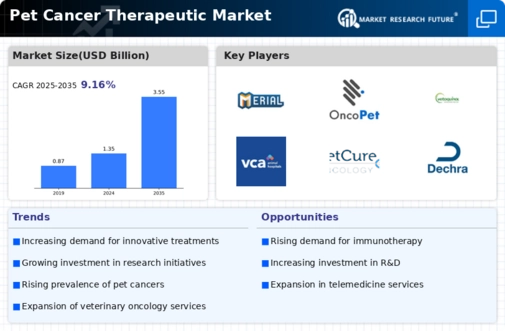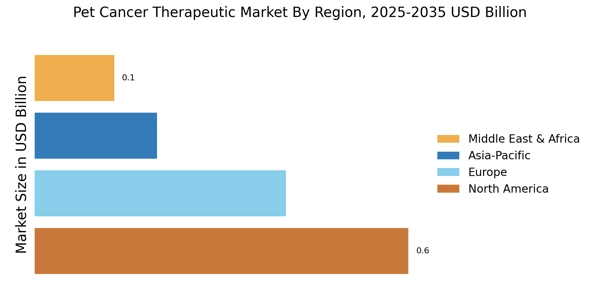Rising Incidence of Cancer in Pets
The increasing prevalence of cancer among pets is a primary driver of the Pet Cancer Therapeutic Market. Recent studies indicate that approximately one in four dogs and one in five cats will develop cancer in their lifetime. This alarming statistic has heightened awareness among pet owners and veterinarians alike, leading to a surge in demand for effective therapeutic options. As pet owners become more informed about the types of cancers affecting their animals, they are more likely to seek advanced treatment modalities. Consequently, the Pet Cancer Therapeutic Market is experiencing growth as pharmaceutical companies and veterinary practices respond to this rising incidence by developing innovative therapies and treatment protocols.
Increasing Demand for Personalized Medicine
The trend towards personalized medicine is becoming increasingly prominent within the Pet Cancer Therapeutic Market. Pet owners are seeking treatment options that are specifically tailored to their pets' unique genetic profiles and cancer types. This shift is prompting pharmaceutical companies to invest in research and development of customized therapies, including gene therapies and individualized treatment regimens. The market for personalized veterinary oncology is projected to grow as more veterinarians adopt these innovative approaches. As a result, the Pet Cancer Therapeutic Market is poised for expansion, driven by the desire for more effective and targeted treatment solutions for pets diagnosed with cancer.
Technological Advancements in Diagnostic Tools
Technological advancements in diagnostic tools are reshaping the Pet Cancer Therapeutic Market. Innovations such as advanced imaging techniques, genetic testing, and biomarker identification have improved the accuracy of cancer diagnoses in pets. These tools enable veterinarians to detect cancer at earlier stages, which is crucial for effective treatment. The integration of these technologies into veterinary practices has led to a more personalized approach to cancer therapy, allowing for tailored treatment plans based on individual pet needs. As diagnostic capabilities continue to evolve, the Pet Cancer Therapeutic Market is likely to expand, driven by the demand for precise and timely interventions.
Enhanced Awareness and Education Among Pet Owners
The growing awareness and education among pet owners regarding pet health issues, particularly cancer, is a significant driver of the Pet Cancer Therapeutic Market. Pet owners are increasingly seeking information about cancer symptoms, treatment options, and preventive measures. This trend is reflected in the rising number of veterinary consultations and diagnostic tests performed. As pet owners become more proactive in managing their pets' health, they are more likely to invest in advanced cancer therapies. The Pet Cancer Therapeutic Market is thus benefiting from this shift in consumer behavior, as informed pet owners are more inclined to pursue comprehensive treatment plans for their pets diagnosed with cancer.
Growing Investment in Veterinary Oncology Research
Investment in veterinary oncology research is significantly influencing the Pet Cancer Therapeutic Market. Increased funding from both public and private sectors has led to breakthroughs in cancer treatment options for pets. For instance, the development of targeted therapies and immunotherapies has gained traction, providing new hope for pets diagnosed with cancer. In 2023, it was reported that funding for veterinary cancer research reached unprecedented levels, with millions allocated to studies aimed at understanding cancer biology in pets. This influx of resources not only accelerates the pace of research but also enhances the availability of novel therapeutic agents in the Pet Cancer Therapeutic Market, ultimately improving treatment outcomes for affected animals.

















Leave a Comment